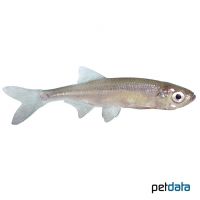Sunbleak (Leucaspius delineatus)
| Sunbleak Leucaspius delineatus | |
|---|---|
| Name | Sunbleak |
| Name Lat. | Leucaspius delineatus |
| Synonym | Moderlieschen |
| Family | Minnows |
| Family lat. | Leuciscidae |
| Order | Carps |
| Order lat. | Cypriniformes |
| Origin | Europe |
| Habitat | Streams, ponds |
| Diet | Omnivore |
| pH | 6.0-8.5 |
| Behavior | Peaceful |
| Keeping | Swarm |
| Care Level | Easy |
| Reproduction | Substrate spawner |
| Breeding | Simple |
| Life Span | 2-4 years |
| Protection | No |
| Metric Units | |
| Size | 6-9 cm |
| Temperature | 4-30 °C |
| Hardness | 12-20 °dH |
| Aquarium | ~ 150 l or ponds |
| US Units | |
| Size | 2.5"-3.5" |
| Temperature | 39-86 °F |
| Hardness | 214-356 ppm |
| Aquarium | ~ 40 gal or ponds |
Distribution and habitat
The range of the Moderlieschen extends from the Rhine and Danube basins to the Urals and the Caspian Sea. They are schooling fish that live in small, weakly flowing or stagnant waters, such as streams, ponds and floodplains, where they stay close to the water surface in dense vegetation near the shore.
Maintenance
The pond should be furnished with pond, floating and underwater plants (oxygenators) and a substrate of sand and round-grained gravel
When maintaining in a cold water aquarium, care should be taken to provide a large swimming area in addition to dense perimeter planting and numerous hiding places (roots, rocks). A soft substrate, oxygen-rich water and slightly shaded light (floating plants) is ideal
No ammonia, ammonium and nitrite should be detectable in the water, the nitrate value should not exceed 100 mg/l. To ensure the water quality and oxygen content should not be missing a filter adapted to the water volume.
Diet
They feed on zoo- and phytoplankton, algae and small approach food (mosquitoes). The food is taken mainly from the water surface. For a balanced diet, feed at least once a day with a high-quality floating pond food (flakes, granules, pellets) as well as cyclops, daphnia, mysis, artemia, plankton, mosquito larvae, etc. (live or frozen). Add some vegetable food, such as commercially available green food (kelp, spirulina).
Behaviour and compatibility
They are lively and sociable fish that do not exhibit any aggressive or incompatible behaviors. At least 10, but preferably more Moderlieschen should be kept together. They can be socialized well with other peaceful pond fish
In principle, only mutually compatible fish species with similar requirements for water quality and water temperature should be socialized.
Reproduction and breeding
The sexes are difficult to distinguish. The female grows slightly larger and appears rounder than the male.
The spawning season is from April to June. The female forms a short laying tube and sticks the eggs, about 1 mm in size, in bands on vertical plant stems (reeds). The male does the brood care. It guards and fans the spawn with fin movements. After 1-2 weeks the larvae hatch.
Important
The name Moderlieschen comes from "motherless" because the spawn, which sometimes sticks to the foot of waterfowl, is carried away to other waters
They tolerate higher temperatures and can be maintained in smaller ponds. Care should be taken when netting them, as they can easily lose their scales.
If they are wintered in the pond, ensure sufficient depth and oxygen supply (filter, oxygenator, ice free holder)
At temperatures below 8-10 °C, the metabolism of the fish slows down and food is no longer accepted; feeding must be stopped accordingly. If the temperature drops further, they hibernate near the bottom. In spring, with rising temperatures, feeding can slowly be resumed. Feeding may also be necessary during prolonged warm periods in winter.
The well-being of the fish should be monitored regularly. A regular partial water change, according to the pond size is recommended, even if the pollutant load has not yet reached the upper limit. Sudden changes in water quality should be avoided. Newly introduced fish must be accustomed slowly to the water in the pond or aquarium
Further literature can be found in your pet store.
References
Text: Werner Winter; Image: petdata
Source: BMELV (1998): Tierschutzgutachten - Haltung von Zierfischen (Süßwasser); RIEHL & BAENSCH (2006): Aquarien Atlas Bd. 1, Mergus Verlag; ENGELMANN (2005): Zootierhaltung - Tiere in menschlicher Obhut: Fische; Harri Deutsch Verlag
- Gemäß § 21 Abs. 5 Tierschutzgesetz idgF
